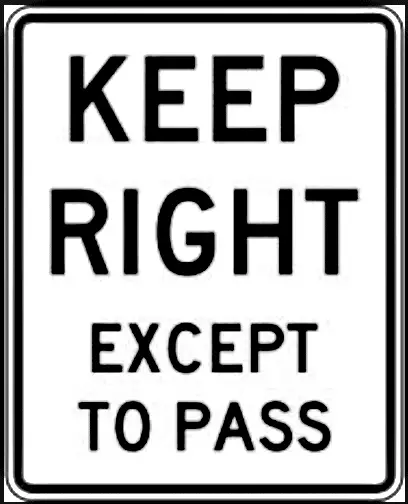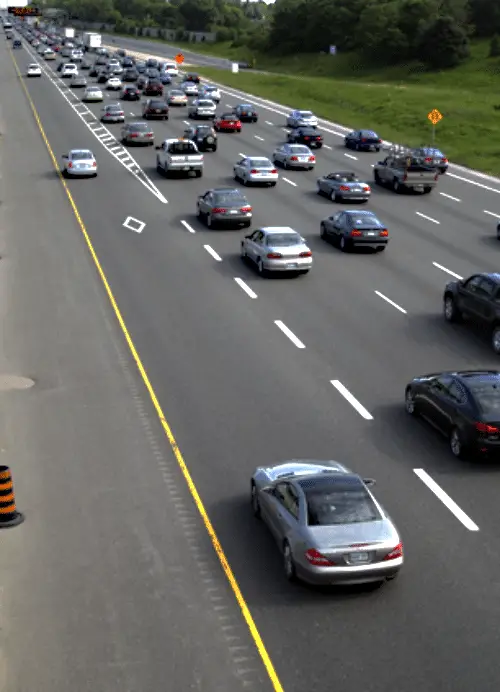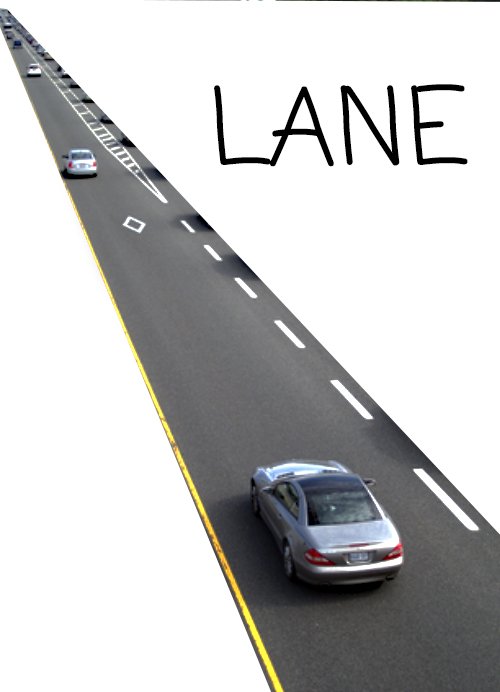Life in the fast lane
Fast lane, what?! It’s a real thing.
I couldn’t help but notice in the news recently, Vancouver Police welcome crackdown on left-lane bandits.
Bandits?

ban·dit
noun
plural noun: bandits
a robber or outlaw belonging to a gang and typically stealing left lanes from other people and operating in an isolated or lawless area.
Maybe this is a good time to review some recommended and regulatory lane usage practices.
The interesting thing to me is that people seem to be able to go through the process of obtaining their drivers’ license in BC, pass a knowledge test and an on-road driving test, and still be unaware of this basic driving principle; much to the dismay of their fellow motorists.
I am not convinced that drivers do this on purpose, waking up in the morning with an agenda to enrage others. It may very well be non-blissful oblivion to the people who view driving as a necessary evil or a chore rather than a religion.
Let’s face it, how many people who are driving down the road are actually thinking about driving down the road?

The Fast Lane – Keep right, Unless to Pass
This is a simple concept designed for maximizing safety on the roads. Anyone just merrily ‘driving along’ should generally try to stay in the right lane. Drivers who are going faster than the flow of traffic and/or passing should use the left lane.
Personally, I think this is much more important on the highway/freeway since the city streets are so commonly congested.
The Fast Lane – Congested Traffic
For example, if you’re stuck in traffic that looks like this, whether on the highway or on city streets, it probably doesn’t matter which lane you are in.
All the lanes are ‘Slow Lanes.’ Is the left lane moving faster than the right lane in this scenario? No, probably not? Is anyone getting mad because you are driving slower than the normal traffic flow in the left lane?
No..everyone is generally mad at being stuck in this mess(!) So the difference is everyone is mad here vs. everyone being mad at ONE vehicle who is driving in the left-most lane at a slower speed or uh, Less Fast than the rest.

The Fast Lane / Slow Lane
However, under normal driving conditions the left lane is considered a fast or passing lane, so if you are not passing another vehicle, going faster than the general flow, or are planning a left turn then don’t “hang out” in this lane.
Consequences of driving slowly in the left lane may include but are not limited to:
- Road rage (which could lead to distracted driving, among other things)
- Aggressive driving
- Tailgating or vehicles following dangerously too close, could lead to collisions
- Collisions as drivers attempt unsafe passing on the right


The Fast Lane – Driving on City Streets
If you’re driving on relatively congested city streets, then consider your particular situation and the potential benefits and problems of each lane before automatically (or uh, mindlessly?) picking the right or left:
In the RIGHT LANE:
- Cars might parallel park in front of you
- Buses or a city bus which might pull over for a long time
- You may have to deal with cyclists
- Pedestrians may be walking close to the road or on the road
- People walking around in between parked cars or parked cars doors opening
- You may have to stop because the vehicle in front of you is turning right and has to stop for pedestrians
- You may have to deal with cars darting out of stop signs or driveways suddenly (or trying to)
- The Canada Post truck or UPS truck parked in the lane?
In the LEFT LANE:
- You are closer to oncoming traffic, and the head-on collision is the worst type. It is better to have a collision or a problem with a vehicle to your right vs. an oncoming vehicle
- Vehicles in front of you might turn left
- You may get to avoid all of the problems driving in the right lane (see above)
HOV LANE
While the HOV Lane (high occupancy vehicle) is commonly located to the left of the other lanes, it still remains an HOV lane and HOV lane ONLY. The number of occupants required is typically displayed on a road sign.

The Fast Lane – This is not a faster-than-the-fast-lane-lane
If the faster lane is moving at a speed faster than the “slow lanes,” and the traffic in the HOV lane is going the same speed or slower than the fast lane, and you still think that all of the traffic is going too slowly, then you may be speeding. Maybe you need to calm down?
The Fast Lane – HOV Lane
The HOV lane is not a place where you can reasonably expect other drivers to automatically go faster, even though the HOV lane is there so that multiples of people riding in a vehicle can benefit from having a designated lane in a “traffic jam” situation otherwise full of single-occupancy vehicles.
This is not meant to be a deep and complicated matter.
On another note, for anybody new to the English language..>> (Alert.. Randomly Off Topic)
Road Lane, the thing the car drives inside:

A road line, the paint on the ground:

also a lane:

Merging onto the freeway
Question: I travel the freeway often and I find it infuriating how people merge onto, or allow other people to merge onto the freeway from the on-ramp.
In the olden days when I took my test, it was actually one of the questions asked of me at the counter after my road test.
If I am in the number one lane traveling at the speed limit along with another car in the #2 lane traveling at more or less the same speed, should I (a) slow down (b) speed up, or (c) maintain the same speed. I answered incorrectly, as the answer was “C”, at least it was back then.
Now it is a daily occurrence that people slow down and yield to vehicles on the on-ramp, causing all sorts of grief. Worse yet are those that try to enter the freeway without yielding at all, nearly side-swiping you into the other lane.
It happens so often that I wonder: Did the rules change about this?
According to ICBC Drive smart Manual, which you can read here,
- It is advisable to adjust your speed to allow merging traffic to merge and/or to help them find a safe gap. It says ‘adjust your speed’ not necessarily slow down OR speed up. Obviously, if two cars are beside each other going the same speed exactly and one is trying to merge then one of them will have to do something about it in terms of adjusting speed. If you are in the vehicle already on the freeway you may be able to look far ahead while driving and be able to adjust your speed very subtly before even getting into the position of being awkwardly beside another vehicle.
- The acceleration lane should be used to match your speed to that of the traffic already on the freeway. In my personal experience, I think this is where most of the problem is. The vehicles merging are sometimes traveling much slower (say 60 km/hr) than the freeway traffic (90 km/hr). Of course, this is highly awkward and difficult to deal with. It is much easier to lane change (which is what merging is, isn’t it) if vehicles are traveling roughly at the same speeds.


Conclusion
Certain lanes are for certain things when driving. Many new drivers (or maybe drivers new to the country) haven’t heard of such things. It’s good to get familiar with it so that you can minimize potential road rage, and help contribute to efficient movement flow.
There’s nothing wrong with being slower than speeding cars, just know which lane you should be using for that. Drive safe! Preparing for your ICBC road test? Be sure to check out my epic article: ICBC Road Test Tips For Classes 5 & 7 [Instructor Gets Deep].
